GMAT Test-Day Tips
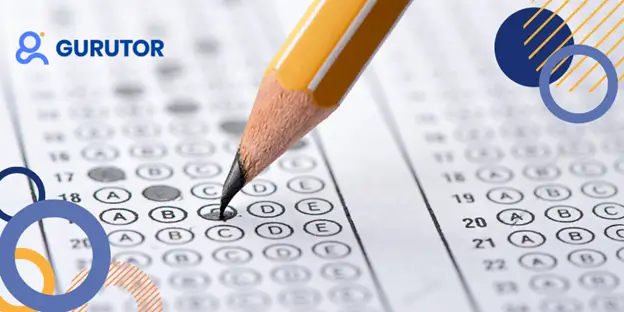
Success on the GMAT isn’t just about the hours you’ve spent studying; it’s about showing up on test day ready to perform at your absolute best.
All the practice and content mastery in the world can fall short if stress, fatigue, or poor planning throws you off balance.
That’s why true GMAT preparation goes beyond solving questions; it means building the focus, confidence, and habits that carry you through the real exam.
This guide brings together practical strategies and GMAT test-day tips, based on proven methods from high GMAT scorers, to help you walk into the test center calm, clear, and in control.
Whether you’re facing the exam for the first time or re-taking the test, these insights will give you the edge you need when it matters most.
GMAT Pre-Test Day Preparation: Set Yourself Up For Success
Your GMAT performance doesn’t start at question one; it starts in the days leading up to the exam.
Test day is a high-performance moment, and like any big event, your preparation needs to cover more than just content.
The way you take care of your body, mind, and logistics will directly influence how sharp, calm, and focused you feel in the testing room.
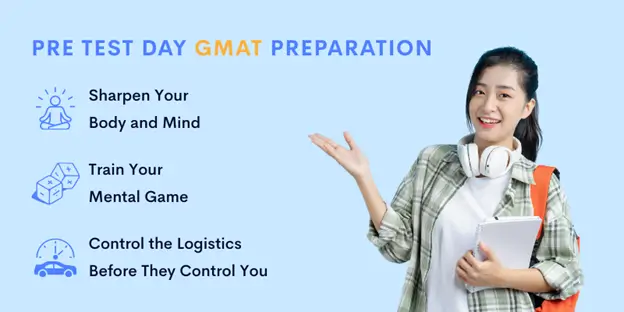
Here’s how to get yourself ready before the GMAT Focus Edition test day:
Sharpen Your Body and Mind
Your brain only works at its best if your body is cared for. Build a steady routine in the days leading up to the test:
- Sleep smart: Don’t trade sleep for last-minute study, clarity beats cramming.
- Fuel well: On exam morning, stick to familiar foods that keep you sharp (think oats, fruit, or eggs).
- Stay hydrated: Maintain a steady water intake, but avoid overhydration right before the test.
- Move and relax: Light exercise, stretching, or even a walk can calm nerves.
- Step back the night before: Close the books by evening. Do a light review if it helps, but prioritize relaxation.
Train Your Mental Game
The GMAT Focus Edition is as much a psychological test as it is an academic one. Top scorers expect ups and downs and don’t let tough moments derail them.
In the final stretch:
- Visualize success: Picture yourself calmly tackling questions, managing your time effectively, and finishing strong.
- Boost confidence: Remind yourself of progress, scores you’ve improved, and questions you’ve mastered. Use positive self-talk: “I’m ready. I’ve done the work.”
- Channel nerves: Some adrenaline is normal, even useful. Establish a routine, such as listening to music, journaling, or practicing breathing exercises, that helps turn nerves into focus.
- Expect challenges: The test is designed to push you to your limits. If a question feels impossible, stay composed and move forward.
Control the Logistics Before They Control You
No matter how prepared you are, poor planning can throw you off. Eliminate surprises:
- Confirm everything: Double-check your test time, location (or online setup), and ID requirements.
- Plan the route: Determine the estimated time it takes to get there. Arrive 30–45 minutes early for a buffer.
- Pack ahead: The night before, set aside your ID, confirmation letter, water, and snacks for breaks.
When you take care of your body, mindset, and logistics in advance, you walk into the exam free to focus on what matters most: performance.
Next, let’s examine what should be in your bag and what you should leave behind.
GMAT Test Day Essentials: What to Bring (and What to Leave Behind)
When test day arrives, the goal is simple: walk in calm, ready, and free of distractions.
That means showing up with only what you need, nothing more.
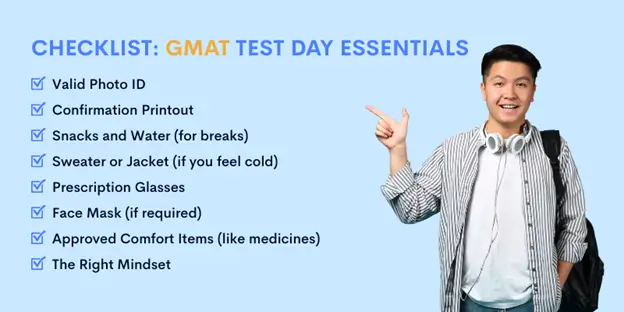
Here are the GMAT test center tips and checklist:
Pack These Must-Haves
- Valid Photo ID: The non-negotiable. Passport, driver’s license, or other GMAT-approved ID with your exact registration name.
- Confirmation Printout: Not always required, but smart to have. It’s your “exam ticket” and backup proof in case of a check-in issue.
- Snacks and Water (for breaks): Keep it light and energizing, such as a granola bar, a banana, or trail mix, along with a clear water bottle.
- Sweater or Jacket: Test centers often run cold. A light, pocket-free layer keeps you comfortable and focused.
- Prescription Glasses: Sounds obvious, but forgetting them is surprisingly common.
- Face Mask (if required): Most centers no longer mandate masks, but rules vary by location. Carry one just in case.
- Approved Comfort Items: Pre-approved medical items (like an insulin pump or wrist brace) are allowed with accommodations. Plan this in advance with GMAC if it applies.
- The Right Mindset: Confidence is part of your gear. You’ve trained for this—walk in with the calm focus of someone ready to execute.
Useful Tip: Pack everything the night before. Having your ID, confirmation, and snacks by the door means one less thing to stress about in the morning.
Leave These Behind
- Phones, Watches, Electronics: No cell phones, smartwatches, calculators, or gadgets of any kind. Even analog watches are banned.
- Study Materials: No notes, books, or papers will be allowed. Scratch pads and markers will be provided. Trust the system.
- Bags, Wallets, Personal Items: You’ll store everything in a locker. Bring as little as possible to the test center to avoid stress.
- Weapons or Hazardous Items: Absolutely not allowed, regardless of permits. Test centers scan and inspect, don’t risk it.
- Bulky Clothing or Accessories: Large coats, scarves, or hats (except religious attire) may be inspected or disallowed. Keep it simple.
Dress for Comfort, Not Distraction
Here’s how to:
- Wear layers: A T-shirt with a light jacket or sweater is ideal. Easy to adjust for temperature.
- Keep it minimal: Avoid wearing flashy jewelry, belts, or anything that might trigger security wands.
- Expect checks: Be prepared to roll up your sleeves or empty your pockets – standard security, nothing personal.
- Plan for focus: If noise distracts you, ask the proctor about earplugs or center-provided headphones.
Remember this checklist, and you’re set for the test-day essentials.
Next, let’s explore test-day strategies, what to do once you’re actually in the hot seat.
In-Test Strategies to Thrive During the GMAT Test
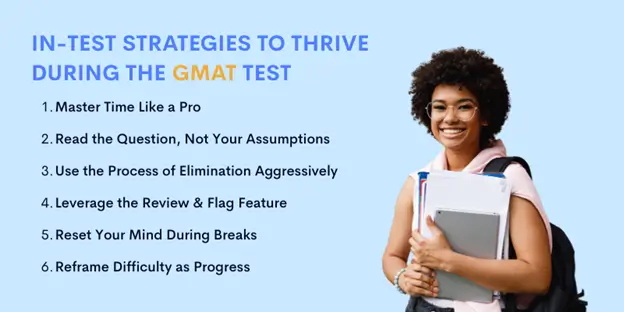
When you sit down at the computer and the clock starts ticking, it’s no longer about theory or prep; it’s about execution.
The GMAT rewards not only what you know but also how you think under pressure.
Here are the most effective GMAT test day preparation strategies to manage your time and approach:
1. Master Time Like a Pro
The GMAT is as much a test of pacing as it is of logic.
Each section has strict timing, and falling even a few minutes behind can create a sense of panic.
- Break sections into mini-goals (e.g., 10 questions in ~20 minutes for Quant).
- Don’t spend more than 2.5 minutes on a single question; if it drags, make your best choice and move forward.
Remember, finishing on time with a few guesses beats rushing and missing several in a row.
2. Read the Question, Not Your Assumptions
Most GMAT errors come from misreading, not a lack of skill. Here’s how to do it:
- Slow down during the first read. Make sure you know exactly what’s being asked.
- Circle or underline key words in your scratchpad (e.g., “integer,” “except,” “least”).
For this, you must build the habit in practice so you don’t burn points on preventable mistakes.
3. Use the Process of Elimination Aggressively
Even if you don’t know the exact solution, narrowing choices boosts your odds.
- Cross out obviously wrong answers first; GMAT often hides traps that “look right” at first glance.
- Compare answer choices against each other; many Data Insights and Verbal Reasoning questions are designed to be solved by elimination.
Remember, at this point, confidence comes not from knowing every answer but from ruling out what can’t be true.
4. Leverage the Review & Flag Feature
The GMAT Focus Edition gives you a rare advantage: you can revisit up to three flagged questions per section. Thus:
- Don’t waste time battling one tough problem mid-section.
- Flag it, make a strategic guess, and move on.
- Circle back at the end only if you have time, when your mind is fresher.
With this, you’ll prevent one question from snowballing into lost minutes and stress.
5. Reset Your Mind During Breaks
Your brain is your most valuable resource on test day; protect it.
- Use the optional 10-minute breaks to stand, stretch, hydrate, and take a breath.
- Avoid overthinking the previous section; treat each break as a reset button.
6. Reframe Difficulty as Progress
Many test-takers panic when questions feel unusually hard, but on the GMAT, that’s a good sign.
Remember, the adaptive algorithm increases difficulty as you perform well.
Instead of seeing a challenging problem as a setback, recognize it as proof you’re on track for a higher percentile.
With these GMAT test day strategies, you’ll stay focused throughout the exam and give yourself the best chance to perform.
After the GMAT: Post-Test Considerations
You’ve crossed the finish line, now what?
Once you’ve completed the exam (and perhaps let out a huge sigh of relief), there are a few post-test considerations to keep in mind.
Here’s what comes next:
Score Reporting: What to Know
Right after finishing, you’ll see your unofficial GMAT Focus scores on screen. Since there’s no essay, this is essentially your full score.
Within 3–5 business days (sometimes up to 2 weeks), GMAC will post your official report to your mba.com account.
You receive five free score reports, provided you send them within 48 hours of receiving your official score.
After that, it’s pay-per-school. Plan so you don’t waste the free window.
Also, GMAT scores are valid for 5 years.
And schools usually focus on your highest score, not an average, so don’t stress about multiple attempts showing up.
Retake Policies: Should You Retake the Exam?
Not everyone achieves their goal score on the first try.
If you’re considering retaking the GMAT, it’s essential to understand the rules and develop a GMAT strategy for improvement.
- Rules
You can retake the exam after 16 days, up to 5 times within a rolling year. The old lifetime cap is gone. Both online and in-person attempts count toward the 5.
- When It Makes Sense
Retake if (a) your score is below practice-test levels, (b) you fell short of your target range, or (c) test-day nerves/timing threw you off.
- What to Expect
Average score gain on a retake is modest (about 30 points). Improvement comes only with a clear plan, not by just sitting again quickly.
- Smart Prep
Analyze weak areas, refine strategies, and use fresh resources or learn through a self-paced system like Gurutor before trying again. The goal must be to do something different so results change.
- Schools’ View
Multiple attempts are common, and schools only care about your best score. Quality prep between tests matters far more than the number of tries.
GMAT Post-Test In-Depth Reflection
Do this soon after the exam, ideally the next day, once you’ve rested, so the details are still fresh in your mind.
- What Went Well
Identify your wins. Your pacing strategies worked perfectly in Verbal, or you felt especially confident on Data Insights.
Acknowledge those strengths; they’re either habits to carry into future prep or victories to celebrate if you’re done.
- What Was Challenging
Be honest about the tough spots. For example:
- Did you run out of time in Quant?
- Did nerves get the better of you in the first few questions?
- Did unfamiliar question types catch you off guard?
Note these immediately.
If you blanked on formulas, that points to more review; if Reading Comprehension passages threw you off, you may need to sharpen active reading skills.
These specifics give you a clear direction for improvement.
- Lessons Learned
The GMAT isn’t just a test of knowledge; it shows how you perform under pressure.
You may have noticed fatigue affecting your accuracy in the second half, which suggests that you should build more stamina through full-length practice tests.
Or perhaps skipping studying for the GMAT a day before left you sharper (or, conversely, too rusty).
These insights will guide how you prep not only for a retake but for other exams or challenges in the future.
- Next Steps if Retaking
Use your notes to fine-tune your study plan. Concentrate on weak areas and practice under realistic test conditions.
For the GMAT Focus Edition, rely on your sectional scores and test-day memory to target gaps.
- If You’re Finished
The GMAT is a demanding exam, and completing it is an achievement in itself.
Be proud of your score and shift your focus to the next phase: applications. Essays, recommendations, and interviews now deserve the same discipline you brought to prep.
And remember, your GMAT score is just one part of your story, not the full picture.
Gurutor: Your Partner for GMAT Success
Unlike other platforms and courses, Gurutor is designed to support you from the day you start preparing through test day and beyond.
Unlike generic courses or static prep books, Gurutor combines expert tutoring strategies, adaptive technology, and real-time feedback to ensure every minute you study moves you closer to your goal.
Here’s how Gurutor sets you apart from other platforms:
1. Targeted Feedback in Real Time
When you make a mistake or approach a question incorrectly, Gurutor provides immediate guidance, showing you exactly where to adjust your thinking.
This ensures you learn the right approach instead of reinforcing errors, a critical advantage over static courses or books.
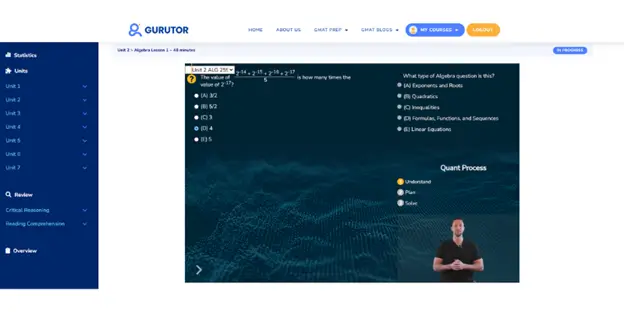
2. Adaptive Practice
Gurutor adjusts in real-time, pushing you with harder questions when ready and reinforcing weaker areas when needed.
Instant feedback ensures mistakes are corrected immediately, so you never practice incorrectly.
3. GMAT-Aligned Coverage
Covers all GMAT topics and difficulty levels, mirroring the official exam.
Each question comes with step-by-step explanations, helping you truly understand concepts rather than just memorizing answers.
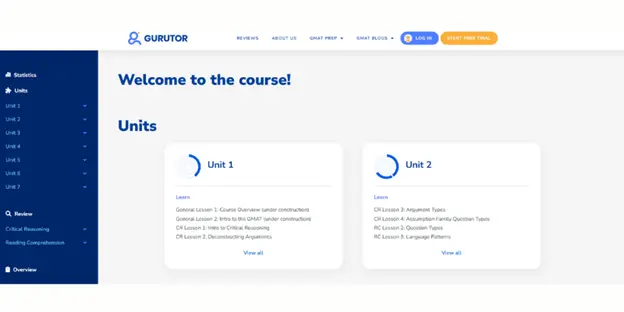
4. Prep Your Way: 3-Month or 6-Month
Whether you’re planning a 3-month sprint or a 6-month journey, Gurutor fits naturally into your personalized study strategy.
It doesn’t dictate your schedule like a GMAT coaching class; rather, you set the pace, but it ensures every session is productive.
5. Built-In Strategy Support
Gurutor tracks patterns, such as timing issues or test-day anxiety, and provides practical strategies to help you overcome them.
By test day, you don’t just know the content, you have the confidence, pacing, and focus to perform under pressure.
6. Simulated Exams and Analytics
Full-length practice tests replicate the real GMAT experience.
Detailed performance analytics track timing, question types missed, and progress trends, helping you fine-tune your strategy and build test-day stamina.
7. Consistent, Reliable Outcomes
Unlike GMAT tutors who vary in quality or prep books that leave you guessing, Gurutor delivers a proven, repeatable system.
Don’t Leave Your GMAT Success to Chance!
Try the first unit free and experience a prep system that adapts to you, gives real-time feedback, and guides you step by step — built on the methods of expert tutoring, but available anytime you study.
